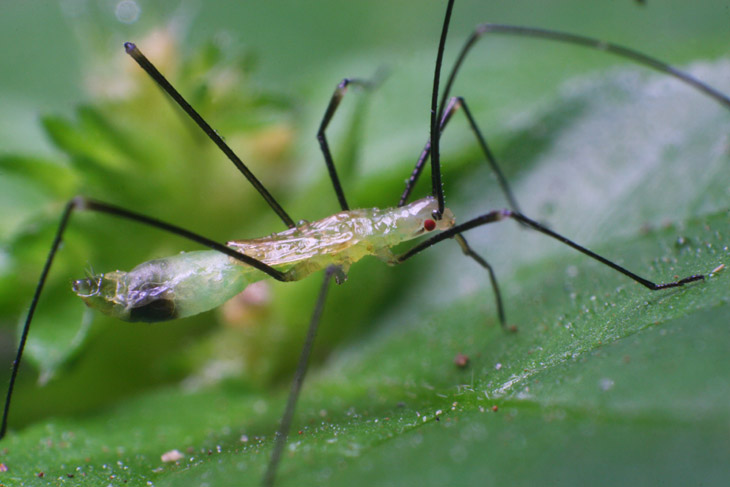
Still involved in many other things right now, so here are a handful of images from the recent past that just never got into blog posts, for one reason or another – some of which may become obvious.
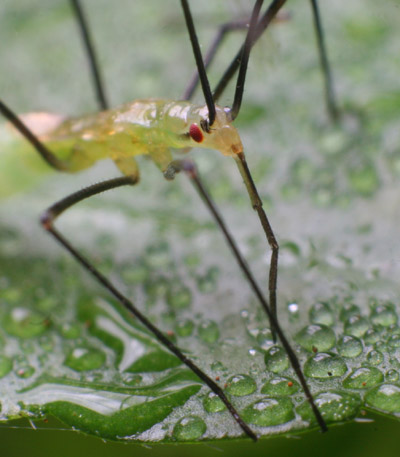 First off we have the most recent images from just a few days ago, an unidentified Hemipteran nymph, quite a small one. I am inclined to call it an assassin bug, but so far I have found no species that matches this coloration (the black legs in particular.) Oddly enough, it was spotted on the kitchen counter, with no good guesses as to how it arrived there, though it might have hitchhiked in on a tomato or basil leaf. It measured just 6mm in body length, and appreciated the water provided by the misting bottle, so it may have been indoors for a while.
First off we have the most recent images from just a few days ago, an unidentified Hemipteran nymph, quite a small one. I am inclined to call it an assassin bug, but so far I have found no species that matches this coloration (the black legs in particular.) Oddly enough, it was spotted on the kitchen counter, with no good guesses as to how it arrived there, though it might have hitchhiked in on a tomato or basil leaf. It measured just 6mm in body length, and appreciated the water provided by the misting bottle, so it may have been indoors for a while.
The long antennae certainly lend them the air of an arachnid, and this may not be coincidental, scamming the predators that don’t like spiders. Or it may simply be a way to seek food while avoiding mites and parasites – you got me. As yet, I’m not even sure if this is a predator or feeds from plants; that proboscis could be used for either, though from the owner’s close resemblance to the pale green assassin bug (Zelus luridus,) I’m leaning towards it having the same habits.
Below, a little bit more of a scale shot, as I deposited it on a geranium bud after the preceding studio images. For some reason, the Canon 30D (at least) seems to over-saturate the reds, and I’m going to have to see what I might be able to do about that. It’s one thing to have vivid colors, but another to look completely unnatural…
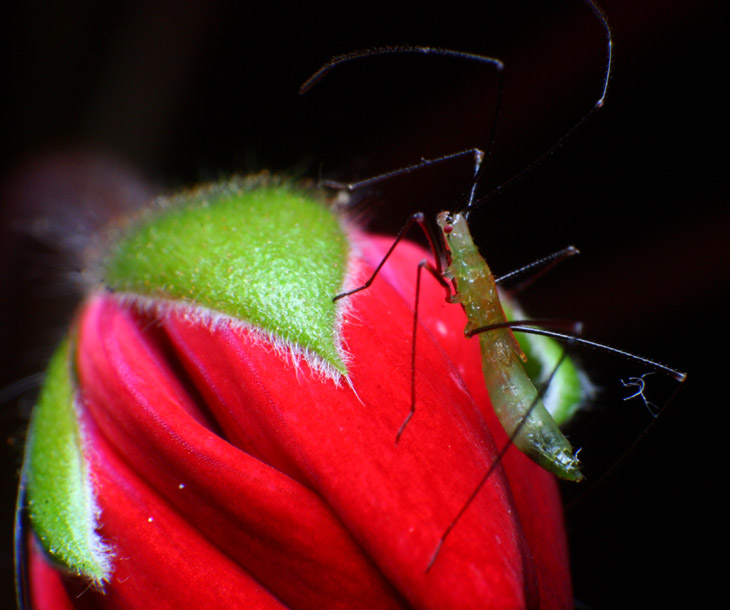
One of the few bits that I’ve accomplished on the backyard pond has been casting a couple of upper ‘pools’ out of concrete, one just large enough to hold a small water pump for a multi-stage waterfall/cascade (there will be a second pump in the pond itself, feeding into this pool.) While there have been frogs in the main pond off and on throughout the season, I found that a small one had decided, for a few days at least, to hang out in the concrete pool. Naturally, it submerged as soon as I drew close, but since the pool is smaller than the average birdbath and holds about 10cm of water, the amphibian wasn’t completely evading detection. I simply sat down nearby and waited it out for a quick portrait.
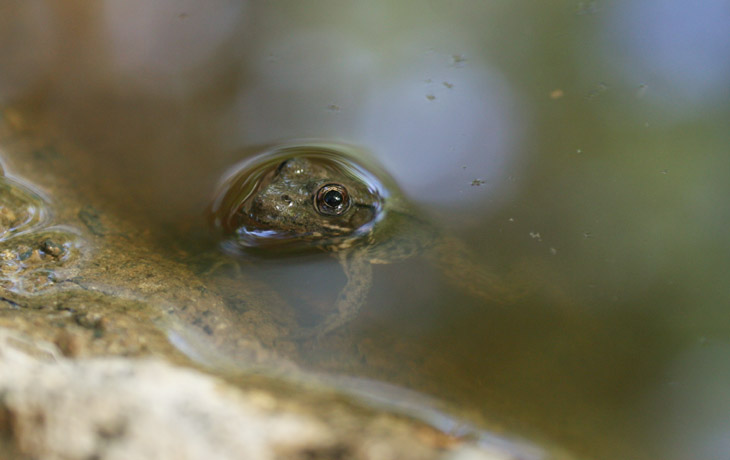
This is a green frog (Lithobates clamitans,) and a small one at that, perhaps 5 or 6cm in body length; I get the impression of a teenager camping out in the yard in a defiant display of semi-independence, though I did not actually see any tattoos or piercings…
But while we’re here, I’m going to throw up a couple of illustrative images. Both of the following were taken from the same position (handheld, so not exactly the same, but very close.) The only change was the focus distance.

The one above is focused on the frog itself, and a hint of the incomplete tree canopy can be seen reflected in the water. Below, I changed focus to the reflection itself which, I have to point out, is not the distance to the water surface, but bounced off of it all the way to the trees.
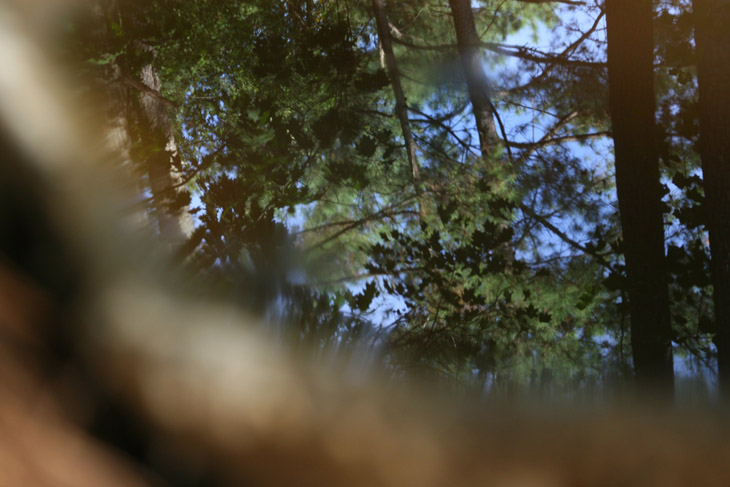
The frog is still there, but defocused to almost complete obscurity. I was shooting from about a meter away from the frog, but the trees themselves were in excess of ten meters off, requiring a radical difference in focus. What also happens in such a case, visible here to some extent, is that focusing actually produces a faint zooming effect, and you may see this a lot in macro work. When composing, you might lean in closer until the subject fits the frame well, but as the focus changes commensurately, it changes the size of the subject within the frame, and you may need to readjust slightly. But certainly, getting both the frog and the reflection focused simultaneously would take a huge depth of field, one that no lens is likely to produce at this distance from the subject.
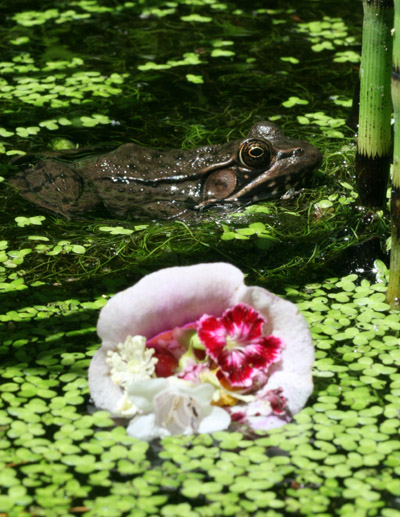 We’ll stick with the frogs for a moment longer before changing the subject, as I show off a photo that I haven’t actually had a good use for yet. This was taken at the NC Botanical Garden, in a pond even smaller than mine (the main one, not the concrete pool above,) and is exactly as found, even though you don’t believe me. Hey, if the frog is going to pose that way and the light is good on both the frog and the flower, who am I to pass that up? This pond, in fact, is what I am patterning my own after, including the scouring rush reeds visible at right, though I’m not sure how well the duckweed (the little spot leaves all over the place) will fare with the cascade feeding in, since this pond lacks such a thing. But the frogs adore it, and that’s part of the reason why I’m putting one in. It’s simply a shame that the tree canopy glimpsed above is so complete that there was no place to put the pond that had good light.
We’ll stick with the frogs for a moment longer before changing the subject, as I show off a photo that I haven’t actually had a good use for yet. This was taken at the NC Botanical Garden, in a pond even smaller than mine (the main one, not the concrete pool above,) and is exactly as found, even though you don’t believe me. Hey, if the frog is going to pose that way and the light is good on both the frog and the flower, who am I to pass that up? This pond, in fact, is what I am patterning my own after, including the scouring rush reeds visible at right, though I’m not sure how well the duckweed (the little spot leaves all over the place) will fare with the cascade feeding in, since this pond lacks such a thing. But the frogs adore it, and that’s part of the reason why I’m putting one in. It’s simply a shame that the tree canopy glimpsed above is so complete that there was no place to put the pond that had good light.
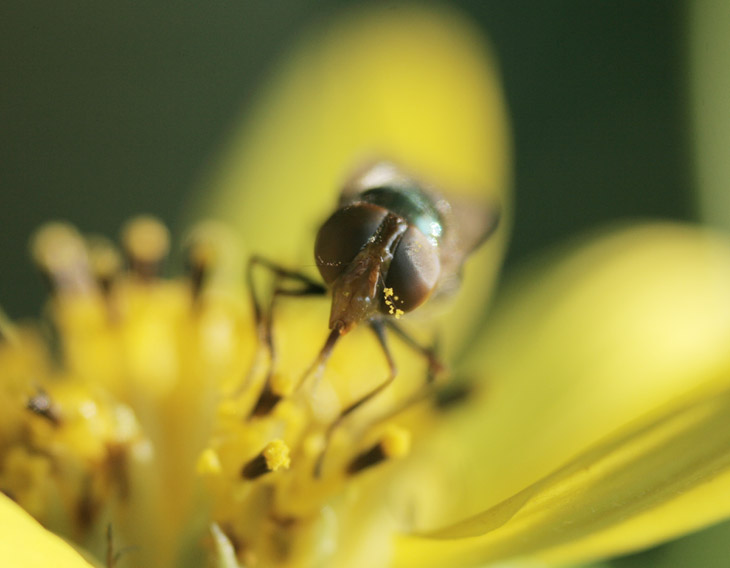
Taken several weeks back now on a student outing, I’m going to take a stab at this being some form of syrphid fly, and leave it at that. It was largely a grab shot as the fly scampered across the flower, but I liked the pollen on the compound eyes and endeavored to get that into focus while shooting in natural light – as you can see, I wasn’t quite bang on. I think we imagine that such a thing obscuring our vision would be very annoying, but who knows how an insect views it? Yet, soon afterward, the fly paused and wiped it away with a foreleg, at least making me feel better.
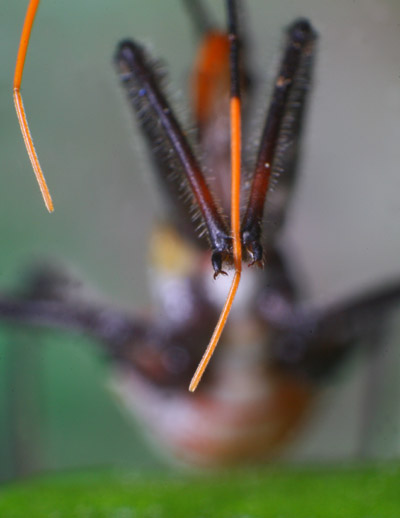 Somehow, I missed putting this one up with the others when I posted about this subject in July. I won’t blame you for being confused by what you’re seeing here, if you are – if not, good on ya! This is a wheel bug (Arilus cristatus) seen head-on like the fly above, cleaning its antenna by clasping it between both forelegs and drawing it through; they actually have small combs on the forelegs specifically for this purpose. It’s a surprisingly deliberate and meticulous action for an arthropod, or so we might think anyway, but undoubtedly necessary for them to function properly – specialized body parts and associated actions don’t evolve for no reason. The bug repeated the action several times, which was good because this is high magnification and pinning down the focus while the insect was moving was challenging, to put it mildly – I tossed several frames where I missed. And I certainly didn’t plan it this way, but catching the one foot against the bright spot on the thorax just made those details stand out so much better. Remember the post where I talked about taking enough frames to capture what was needed? Yeah…
Somehow, I missed putting this one up with the others when I posted about this subject in July. I won’t blame you for being confused by what you’re seeing here, if you are – if not, good on ya! This is a wheel bug (Arilus cristatus) seen head-on like the fly above, cleaning its antenna by clasping it between both forelegs and drawing it through; they actually have small combs on the forelegs specifically for this purpose. It’s a surprisingly deliberate and meticulous action for an arthropod, or so we might think anyway, but undoubtedly necessary for them to function properly – specialized body parts and associated actions don’t evolve for no reason. The bug repeated the action several times, which was good because this is high magnification and pinning down the focus while the insect was moving was challenging, to put it mildly – I tossed several frames where I missed. And I certainly didn’t plan it this way, but catching the one foot against the bright spot on the thorax just made those details stand out so much better. Remember the post where I talked about taking enough frames to capture what was needed? Yeah…
And one last one, that just didn’t fit in anywhere else (and probably doesn’t here either.)
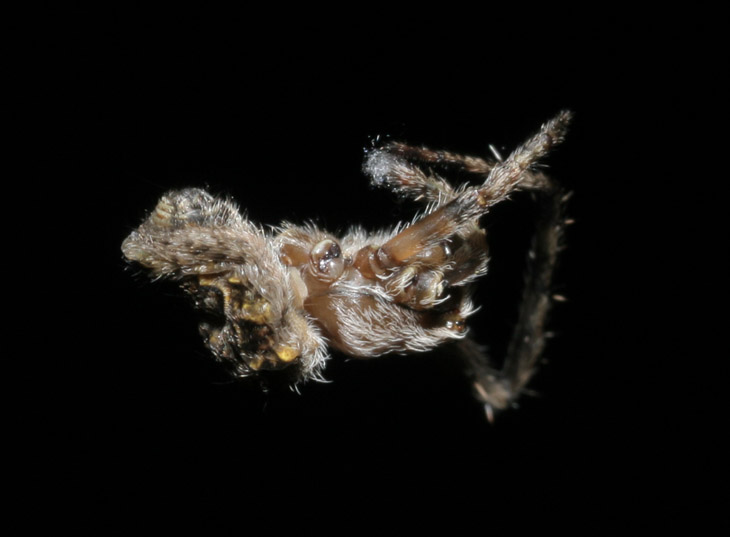
On the same outing as the maybe-syrphid fly above, I spotted this small spider clambering up a web strand just off the walking path, noticeable partially because I’m me, but also because I was almost certain it had only two legs. One examining the photos, I can see three, so it’s not quite as bad off as I originally believed, but still not good, and the motion it was using to climb back up its own web was most unspiderlike. I’m fairly certain this is a variety of cribellate orb weaver (family Uloboridae,) the only spider species that has no venom (I’ll let you speculate on whether that played any part in this specimen’s sorry shape.) I used the flash this time, mostly because I couldn’t possibly stop the action in the deep shade where the spider was, and while I did get some nice sharp images, they still don’t illustrate things very well – you’re seeing the spider from the left side, belly up, abdomen to the left of the frame (it always looks like that, I believe) and a couple of the eyes visible at the base of the shadowed leg. One stump is plainly visible. It would be easy to believe these handicaps would have some effect on the energy of the spider, but not to my observations; the bug-eater was ripping right along. By the way, this was taken at 8:36 am on a bright day, but 1/250 second at f16, aiming into deep shade, was enough to render the background pure black, even at ISO 320 – it’s that ‘every macro photo is taken at night’ trait that can be hard to overcome. Just for kicks, I went in and played with the light levels in the image to see if anything could be discerned in the background, with no luck at all; it’s black. Black black black. It’s just a shame that I couldn’t get a better view of the spider, but it was plugging along so gamely that I didn’t feel right in collecting it for studio work. I’ve spotted a couple of cribellates nearby, so at some point I may be back with better illustrations of what one is supposed to look like. I know you just can’t wait.





















































 I had originally identified this flower as a winter aconite, Eranthis hyemalis, but now I’m pretty sure that’s wrong – the leaves aren’t like that, and no image I can find shows this green translucent ‘berry’ springing from the middle. So if you know what this is, feel free to enlighten me. All I can say right now is that these are tiny flowers perhaps a centimeter across, that appear very early in the spring – last year they got
I had originally identified this flower as a winter aconite, Eranthis hyemalis, but now I’m pretty sure that’s wrong – the leaves aren’t like that, and no image I can find shows this green translucent ‘berry’ springing from the middle. So if you know what this is, feel free to enlighten me. All I can say right now is that these are tiny flowers perhaps a centimeter across, that appear very early in the spring – last year they got 
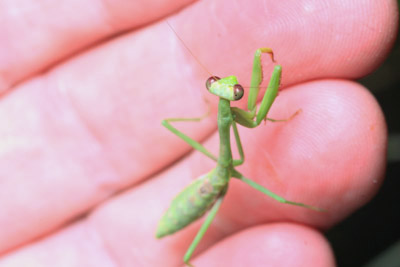 While coaxing it around for a better view, it scrambled onto my hand without a qualm, and I juggled the camera around one-handed for a quick scale shot. Then, as I tried to convince it to get back onto the maple tree, it resisted playfully and trotted up my arm all the way to the short sleeve cuff, before I could brush it back onto the tree. It would seem I now have a reputation for making mantids famous. Either that or my beard looked like a tasty bug – your call.
While coaxing it around for a better view, it scrambled onto my hand without a qualm, and I juggled the camera around one-handed for a quick scale shot. Then, as I tried to convince it to get back onto the maple tree, it resisted playfully and trotted up my arm all the way to the short sleeve cuff, before I could brush it back onto the tree. It would seem I now have a reputation for making mantids famous. Either that or my beard looked like a tasty bug – your call.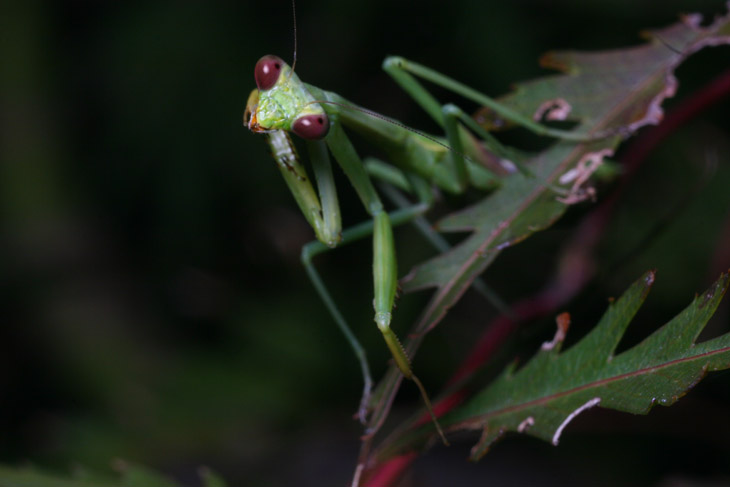


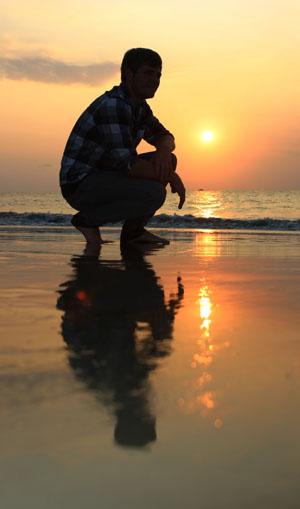 From a nature photography standpoint, as well as portraiture, one of the better bits of planning is using the best natural light. Sunrise and sunset, often referred to as the ‘golden hours,’ offer softer, low-contrast lighting that has a pleasant warm hue, not to mention often producing nice displays in the sky, so being in position when this occurs can be very useful. If you don’t have a developed sense of where the sun will be, a compass and any online guide or app can tell you exactly where it will contact the horizon, allowing you to use this tiny window to frame the sun (or moon, as it may be) against some foreground interest. The colors change rapidly at these times, and the best displays may last only a minute or so.
From a nature photography standpoint, as well as portraiture, one of the better bits of planning is using the best natural light. Sunrise and sunset, often referred to as the ‘golden hours,’ offer softer, low-contrast lighting that has a pleasant warm hue, not to mention often producing nice displays in the sky, so being in position when this occurs can be very useful. If you don’t have a developed sense of where the sun will be, a compass and any online guide or app can tell you exactly where it will contact the horizon, allowing you to use this tiny window to frame the sun (or moon, as it may be) against some foreground interest. The colors change rapidly at these times, and the best displays may last only a minute or so.
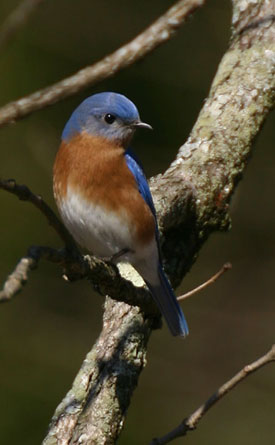 Anticipating the action is also an important facet. This might mean setting up a complete rig to be able to capture birds feeding their young without being close enough to spook them, with light levels adjusted ahead of time so everything’s ready when the action starts. Or it might simply be knowing what pose or position is going to work best, and being able to trip the shutter exactly when it occurs, no matter how fleetingly. Most animals look better with a bright point reflection in their eyes, called a ‘catchlight,’ but don’t often pose where this can occur because it also means that light is making it hard for them to see; thus it might happen for a second or less. Yes, this takes practice and fast reflexes – you’re seeing the successes here, but I have enough misses as well. A little forethought made me position myself so that the bluebird’s head fell in the gap between the background branches, rather than intersecting them in a distracting way, and then it was simply a matter of waiting until the bird turned to look in exactly the right direction.
Anticipating the action is also an important facet. This might mean setting up a complete rig to be able to capture birds feeding their young without being close enough to spook them, with light levels adjusted ahead of time so everything’s ready when the action starts. Or it might simply be knowing what pose or position is going to work best, and being able to trip the shutter exactly when it occurs, no matter how fleetingly. Most animals look better with a bright point reflection in their eyes, called a ‘catchlight,’ but don’t often pose where this can occur because it also means that light is making it hard for them to see; thus it might happen for a second or less. Yes, this takes practice and fast reflexes – you’re seeing the successes here, but I have enough misses as well. A little forethought made me position myself so that the bluebird’s head fell in the gap between the background branches, rather than intersecting them in a distracting way, and then it was simply a matter of waiting until the bird turned to look in exactly the right direction.
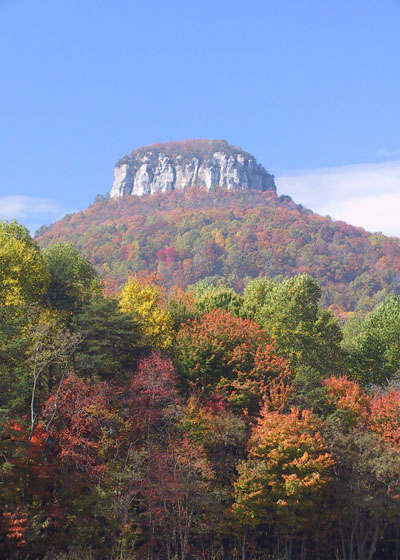
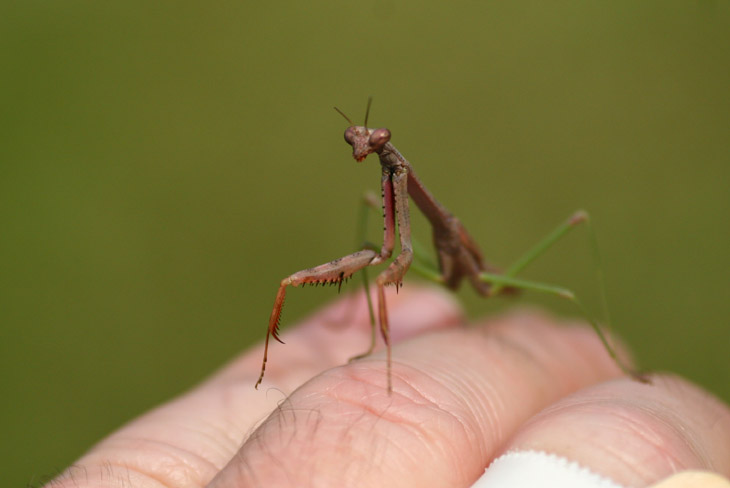
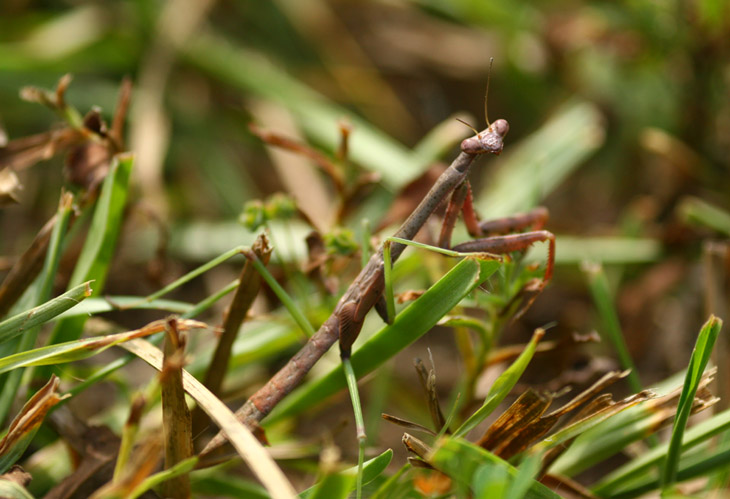
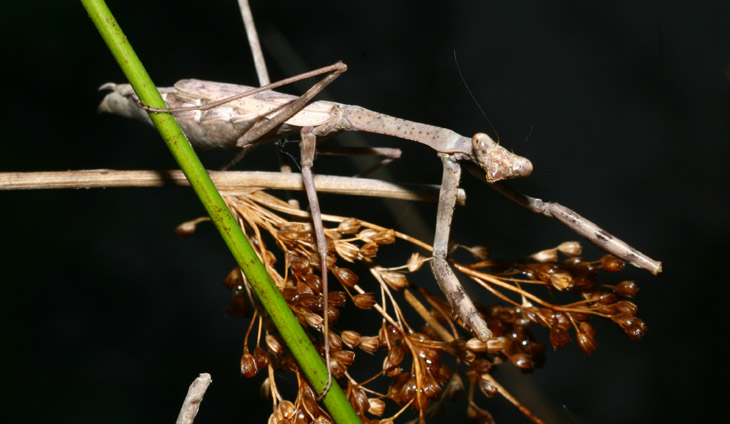
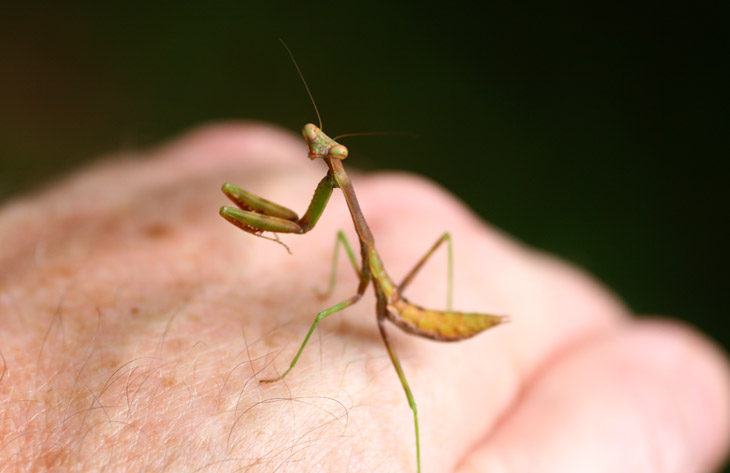
 [That’s two of my knuckles flanking the head, with my thumb peeking in at right.] This time, however, I knew exactly how it had gotten there, since I had just brushed past a low-hanging branch with that shoulder, so after the scale image, I returned it to its perch.
[That’s two of my knuckles flanking the head, with my thumb peeking in at right.] This time, however, I knew exactly how it had gotten there, since I had just brushed past a low-hanging branch with that shoulder, so after the scale image, I returned it to its perch.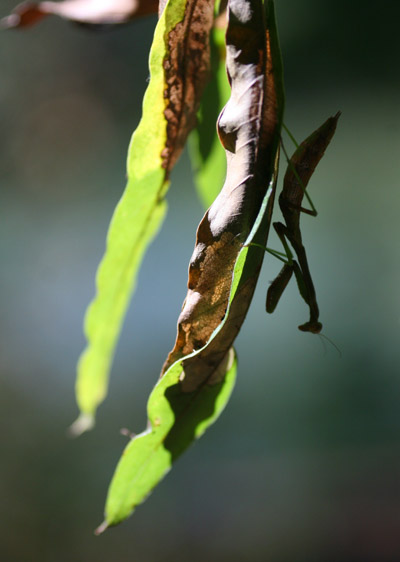 This one’s from yesterday, and as you can see, that abdomen is still pretty impressive. I can’t offer a decent explanation as yet – the tree is hardly one to attract a lot of potential mantis-meals. I am not discounting the possibility that, had I not acted sooner on that first encounter, the mantis may have been fatter still, feeding from those like me who frequently walk around the pond. But the path I took is one seldom used, because the spiders tend to throw their webs across between the trees and, for some reason, most people don’t like walking face-first through a large orb web – I’ve pointed it out many times before on this blog, but people are weird. However, this might help explain the girth anyway. The orb-weaver spiders don’t often encounter mantids because of their own protective habits, sitting in the middle of the web where mantids cannot reach, but they do at least have to begin the web, which requires stringing the support strands, and the outlying branch that the mantis owns is potentially a good anchor for such. So maybe the mantis had been fortunate enough to stumble upon a self-stocking smorgasbord, as it were.
This one’s from yesterday, and as you can see, that abdomen is still pretty impressive. I can’t offer a decent explanation as yet – the tree is hardly one to attract a lot of potential mantis-meals. I am not discounting the possibility that, had I not acted sooner on that first encounter, the mantis may have been fatter still, feeding from those like me who frequently walk around the pond. But the path I took is one seldom used, because the spiders tend to throw their webs across between the trees and, for some reason, most people don’t like walking face-first through a large orb web – I’ve pointed it out many times before on this blog, but people are weird. However, this might help explain the girth anyway. The orb-weaver spiders don’t often encounter mantids because of their own protective habits, sitting in the middle of the web where mantids cannot reach, but they do at least have to begin the web, which requires stringing the support strands, and the outlying branch that the mantis owns is potentially a good anchor for such. So maybe the mantis had been fortunate enough to stumble upon a self-stocking smorgasbord, as it were.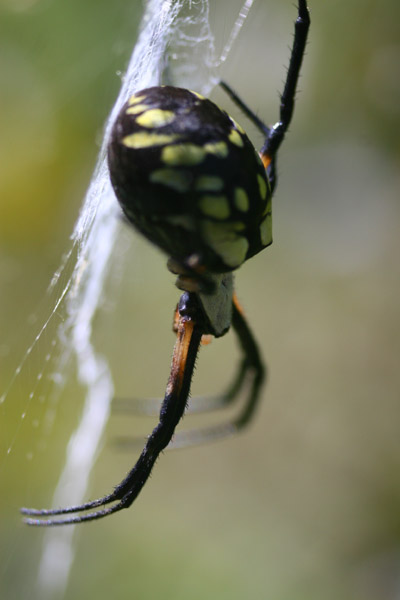 While I was faintly chagrined at having missed the hatching, I wasn’t absolutely sure a hatching had occurred. The egg sac might have been found and raided by a predator, a hypothesis buttressed by the fact that there was no evidence of a large number of web strands left behind by dozens of departing spiderlings. Not far away, though, another argiope was perched, and her girth was also evidence of an impending sac – this was taken four days ago. The thorn bushes she had selected as her web anchors prevented me from getting a better viewing angle, but as you can see, her belly’s to the sun anyway.
While I was faintly chagrined at having missed the hatching, I wasn’t absolutely sure a hatching had occurred. The egg sac might have been found and raided by a predator, a hypothesis buttressed by the fact that there was no evidence of a large number of web strands left behind by dozens of departing spiderlings. Not far away, though, another argiope was perched, and her girth was also evidence of an impending sac – this was taken four days ago. The thorn bushes she had selected as her web anchors prevented me from getting a better viewing angle, but as you can see, her belly’s to the sun anyway.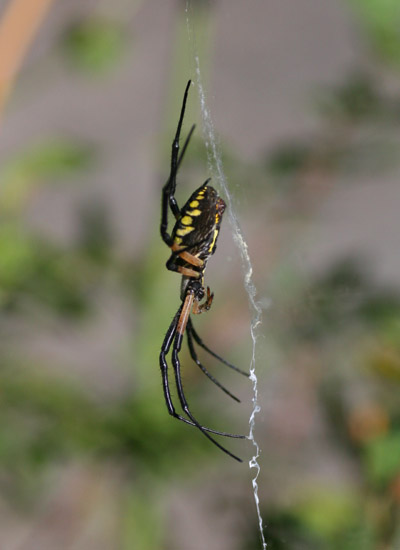 Yesterday, the same spider as above was noticeably deflated, as predicted, but I was unable to locate the egg sac. The foliage nearby was dense, and argiopes don’t put their eggs in the immediate vicinity of their webs, opting to go outside of the orb’s range a short ways (usually less than a meter) to place the sac. It was almost certainly there, but ten minutes of searching didn’t reveal it to me. I’m going to keep checking, because I really want photos of newborns, and if I capture them in the process of emerging, all the better. It will also be interesting to see if, now that the eggs are laid, this one disappears soon as well. Check back – if I’m successful, you know they’re going to appear here.
Yesterday, the same spider as above was noticeably deflated, as predicted, but I was unable to locate the egg sac. The foliage nearby was dense, and argiopes don’t put their eggs in the immediate vicinity of their webs, opting to go outside of the orb’s range a short ways (usually less than a meter) to place the sac. It was almost certainly there, but ten minutes of searching didn’t reveal it to me. I’m going to keep checking, because I really want photos of newborns, and if I capture them in the process of emerging, all the better. It will also be interesting to see if, now that the eggs are laid, this one disappears soon as well. Check back – if I’m successful, you know they’re going to appear here.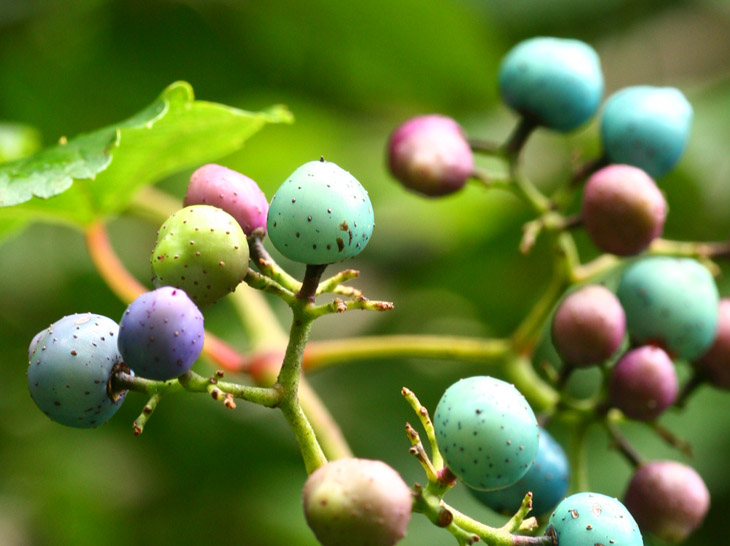

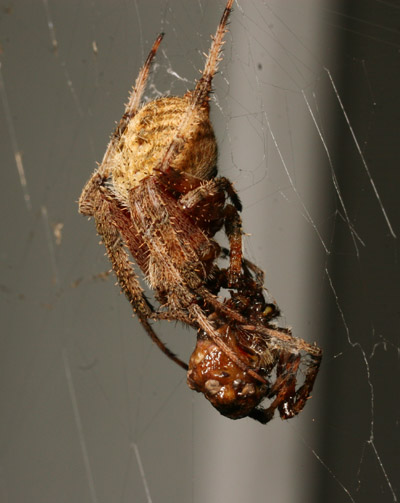 So, right outside the same porch mentioned in the previous post has been a pair of large orb webs occupied by
So, right outside the same porch mentioned in the previous post has been a pair of large orb webs occupied by  What I found was a vintage barn or railroad lantern, and it arrived in “as found” condition, complete with old spider egg sacs (barely visible to the lower right of the chimney.) It took a while to clean up, and the kerosene had stained the enamel around the base, but I figured that just added to the rustic charm. Despite the grime, it was in good enough condition that I could have filled it and lighted it immediately, and I debated about cleaning it up and reselling it, but I liked the look of it too much. Once cleaned, I removed the wick assembly and drilled a large hole in the bottom of the kerosene tank, then fed the lights up through the bottom and clustered them within the glass chimney. From discussion to result was less than two weeks, and from arrival to display less than two hours.
What I found was a vintage barn or railroad lantern, and it arrived in “as found” condition, complete with old spider egg sacs (barely visible to the lower right of the chimney.) It took a while to clean up, and the kerosene had stained the enamel around the base, but I figured that just added to the rustic charm. Despite the grime, it was in good enough condition that I could have filled it and lighted it immediately, and I debated about cleaning it up and reselling it, but I liked the look of it too much. Once cleaned, I removed the wick assembly and drilled a large hole in the bottom of the kerosene tank, then fed the lights up through the bottom and clustered them within the glass chimney. From discussion to result was less than two weeks, and from arrival to display less than two hours.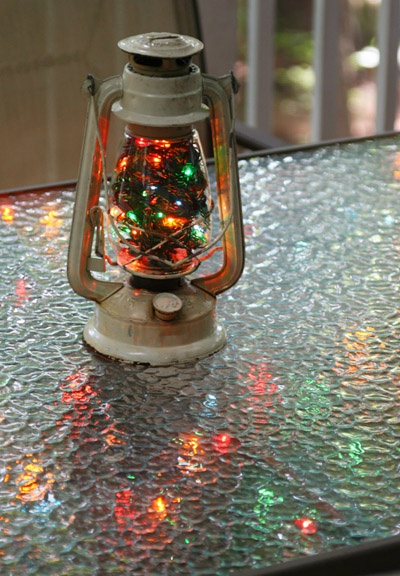 It looks quite nice in place, and my only regret is that it is not self-contained and running from batteries, with that fill-spout serving as the power switch. Even during the day, it produces a nice effect, but at night it really comes into its own. I know there are some people that think multi-colored lights are garish or old-fashioned; good for them. We’re pleased with the ensemble, and that’s the only criteria we need.
It looks quite nice in place, and my only regret is that it is not self-contained and running from batteries, with that fill-spout serving as the power switch. Even during the day, it produces a nice effect, but at night it really comes into its own. I know there are some people that think multi-colored lights are garish or old-fashioned; good for them. We’re pleased with the ensemble, and that’s the only criteria we need.